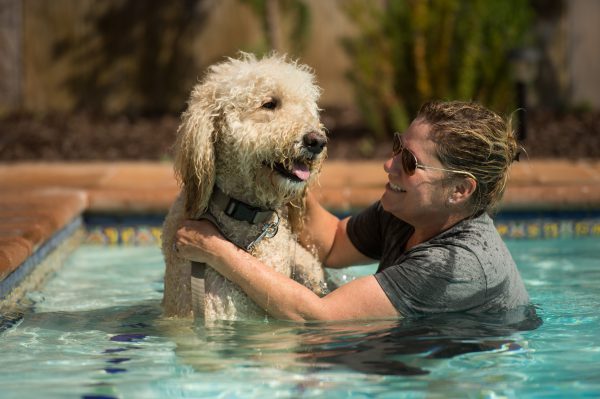Summer is here and it’s the perfect time to cool off at the pool or beach, especially with your four-legged friend by your side. But before you let your dog jump into the water with you, it’s important that you first teach your dog how to swim.
Whether your dog is a natural swimmer (like a Labrador Retriever, Newfoundland, Portuguese Water Dog, Poodle) or has the buoyancy of a brick (Bulldogs, French Bulldogs, Pugs, Basset Hounds), we’ve got some great ways for getting your dog comfortable in the water.
Here are a few tips from our very own partner trainer and Pool Safety instructor, Rhonda Feinberg, on how to teach your dog how to swim.

Slowly Introduce
Instead of pulling your dog into the water right away, start by introducing them with a small kiddie pool. Get your dog comfortable by sitting down in the kiddie pool with them and gently splash water over their body. When they gain more confidence and start walking around the baby pool, you can move to the bigger pool. If you don’t have an inflatable pool, you can carefully introduce your dog to the water by sitting with them at the top step or entry point of your pool or body of water.
Do Not Force
Whatever you do, do not force or pull your dog into the water. The learning process should be fun and rewarding and you don’t want them to associate water with a negative experience. The key is to be patient and take time getting them comfortable with the water. Once your dog has calmed down and is comfortable on the stairs of the pool or standing in a body of water, you can cradle them in your arms and slowly move them around in the water until they are relaxed. A good tell that they have loosened up is when they start moving their legs in the water as a way to guide themselves. If your dog starts to panic while you’re holding them, slow down and take them back to the step or standing area so they can recoup.
Always Be in the Water
For safety and learning purposes, it is important to always be in the water with your dog while teaching them how to swim. If they start to panic, you want to be able to calm them down as soon as possible. Also, your dog will feel safer and more comfortable learning if you are holding them. You can also put a leash on your dog while you’re in the water with them to help guide them while they swim. Most importantly, make sure you are able to stand at the bottom of the pool if needed, especially if you have a large dog because if your dog starts to panic there is a large chance they will try to hold onto you and sink you to stay afloat.

Create an Entry and Exit Point
One of the most important steps in teaching your dog how to swim is creating an entry and exit point. Make sure it is somewhere they can easily get in and out of, like a slope or stairs, and that the entry point is the same as the exit point. Most drownings occur when a dog swims to the side of the pool, struggles to get out of the pool and becomes exhausted. It helps to have a visual guide that your dog can refer to when trying to get out. This can be anything from a potted plant to an umbrella. Have your dog get into the pool next to the guide and then help them get out at the same point. When swimming, you can point your dog toward the exit point and help them get out. Also, reward them with treats every time they access the points.
Be Consistent
It is recommended to take your dog out in the water at least a couple times a week, if possible. The more you take them into the pool, the more likely they are going to be comfortable in the water. However, you want this to be a positive experience for you and your dog. If they are uncomfortable or stressed, take your time and don’t force your dog to get into the water if they do not want to.

Start Them Young
When you get a puppy, it is best to introduce them to water at an early age. Around the three month mark, you can use your bathtub or a kiddie pool with an inch or two of water as a starting point. Make it fun and give them lots of treats. You can also carry smaller puppies into the water with you and slowly let them get the hang of water as you move around with them.
Have Fun
Most importantly, remember to have fun! Swimming shouldn’t be scary and it’s crucial for your dog to associate water with something positive. Also, keep the lessons short. You don’t want them to become mentally and physically exhausted or else they’ll learn to dislike the activity. Act, encourage and praise your dog as they are learning to swim. And don’t forget to reward them with high quality treats (like hot dogs or cheese), it will make a huge difference in the learning process.
Don’t have the time or resources to teach your dog how to swim? Consider signing them up for our Pool Safety Class every Thursday afternoon. Dogs learn to swim with confidence, safely exit and enter the pool, plus have a blast with friends. This is a training-based class at our trainer Rhonda Feinberg’s home in Los Angeles.
